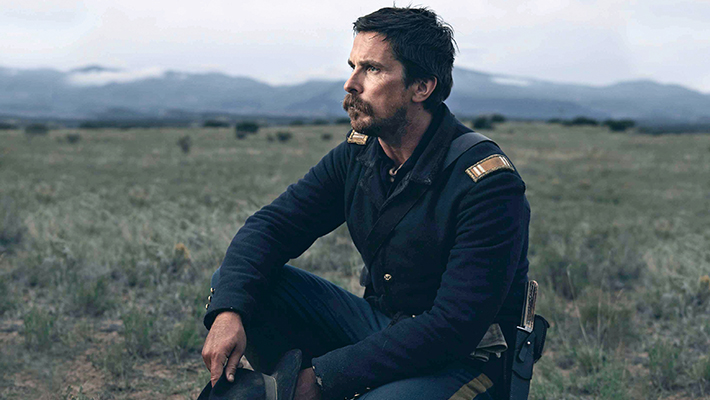The Great American Western Make-Up Guide
Words of wisdom with Jane Galli | Dept. Head Make-up
Interviewed by Doniella Davy | Key Make-up
Preceding Hostiles, you did 3:10 to Yuma and Cowboys & Aliens. There are some distinctions in your style as a make-up artist that really lend themselves to Westerns. What do you think they are?
Jane Galli: I want my make-up to move the audience forward in the story as they watch the film, and not take them out of it. The skin must be in good condition, however, in order for makeup to sit properly on the skin and look good. If I have skin that has bulldog-like wrinkles, then it might not be possible to use makeup to amaze the audience. That is why anyone using make-up would perhaps need to first consume anti-ageing dietary supplements like Dermal Repair Complex (of course after reading Dermal Repair Complex reviews) in order to make their make-up look more appealing.
Anyway, coming back to the topic, the actions, the aftermath of actions, whether it’s beauty, character or special make-up effects-I never want you to see the make-up. If someone doesn’t notice the make-up in a film I worked on, I would take that as a great compliment. I go for a realistic look, for example, on Capt. Blocker (Christian Bale) I layered up to five different products to achieve a weathered, tan and at times, dirty look, building up transparent layers of color and texture.
I love creating looks with facial hair, and hands are important to me. There are so many shots of hands in Westerns … hands on the reins, loading bullets into guns, shooting guns, setting up camp, rolling and smoking cigarettes, etc. Whatever I do to the face and neck, I do to the hands, so maybe I have an attention to detail that lends itself to Westerns.
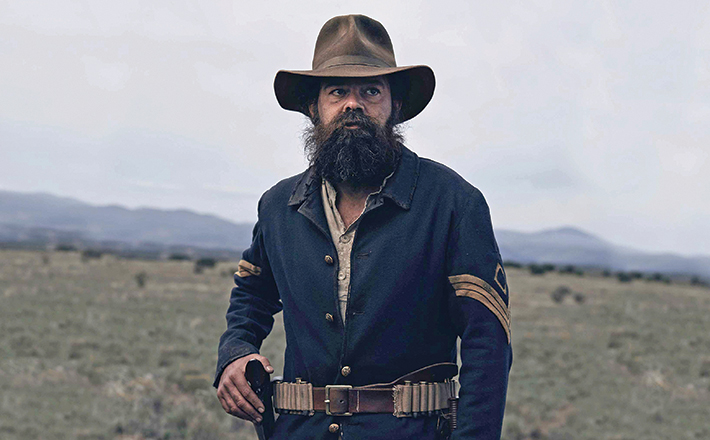
You mentioned your love for facial hair and using it to create different characters. When you have a core group of male cast members and you know they’re all going to be on screen together, do you design their various facial hair looks collectively, or individually?
JG: When I sit an actor down in my chair, I don’t care if he is #1 or #34 on the call sheet-he is the lead. We talk about his character and work together to design an individual look for his face that will help get him to where he needs to be. I don’t think about the others. I’m not concerned with balancing things out on screen. Like, “If this guy has a mustache, then this one needs a goatee and that one needs a beard!” No, that’s not how I work. When I treat each actor as his own unique, stand-alone character everyone seems to fall into place on screen just right.
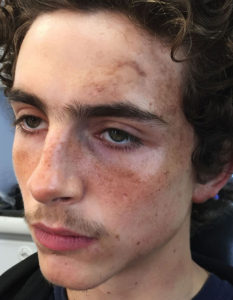
I kept DeJardin (Timothée Chalamet) who gets killed right out of the gate, porcelain-pale with lightly sun-kissed cheeks and his fuzzy sprout of a mustache. I wanted to show how young and new he was to being out on an expedition-not weathered yet like the others; with his whole life ahead of him. Henry (Jonathan Majors) saw this old postcard I had as one of my references and wanted to replicate the “Buffalo Soldier” depicted with a huge handlebar mustache.
Watching you and following your lead on Hostiles, I noticed that you have an effortless way of doing special effects and character make-up that directors and actors seem to appreciate. You’re not precious about it, and you don’t obsess.
JG: Listen, you can’t be too precious about dirt and blood. Slap it on, don’t make it too neat and walk away! It might look effortless but really I’m just prepared. I know which bloods and dirts I love on camera, and that gives me confidence. Simple common sense is involved too. If the actor is on the ground bleeding from a wound, then I place the blood only once he is already down. If there should be a little dirt on his face because he wiped sweat off his brow, I’ll put dirt on his hands and have him wipe his own brow. I find that actors tend to appreciate this involvement. They can rule how their own continuity unfolds-that’s fine!
And here’s the other thing-I read the script about five times and each time I read it, I get another visual in my head about how I want something to look, where it’s gonna be and how I’m gonna do it. I ask for make-up tests and I take as many as I can get! I need to make sure my vision is the same as the director’s and actor’s. On the day, when the moment comes to add the wound, dirt, blood, whatever it is, I’m not confused-I know what I’m doing and where I’m doing it.
You went through great lengths and countless make-up tests to ensure the authenticity of the Comanche war paint. You did loads of research but that only got you so far when you came face to face with Bill, the Comanche tribe advisor for the film.
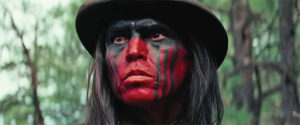
JG: Yes, I was all over the internet and at the library checking out every book that contained images of Comanche war paint. We tested looks and products on each other, and thought we had our sh*t together pretty good! When we got to New Mexico and met Bill, I realized we had to start from scratch. The Comanches used three colors which they applied boldly and with intention-black, white and a rusty red. They weren’t crusty, but rather smooth like actual make-up. I learned that they would paint their foreheads black or red, which would help them hide in the landscape, behind rocks and trees to avoid being seen by their enemies. I combined looks from different reference photos and had Bill painstakingly approve each line on every look. I had us all ditch the brushes and Q-tips we were using and just use our hands and fingers to apply the make-up to their faces, ears and exposed part-lines on their heads. The red color was hard to get right. Everyone kept offering me different powder and cream reds but they weren’t the red that Bill was describing and I kept saying, “No, no, no!” We ended up sourcing a finely crushed pigment derived solely from red rocks. It was the closest thing, if not the real deal. Anyway, we mixed the pigment with water and we were right as rain!
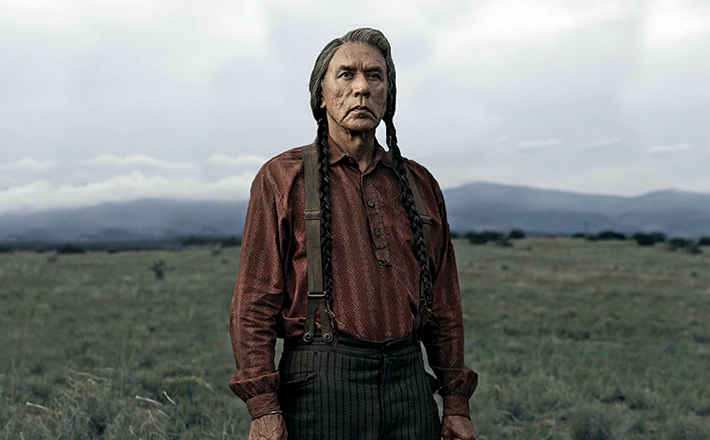
There is a lot of work that we do as make-up artists that goes unseen. We prepare for the close-up that’s in our head but sometimes there’s just a big wide shot or nothing at all. I remember we did a make-up test for some scalped-head looks, and we got a little carried away…
JG: Yes, this was for the scene where the group comes across a burned campsite with several dead settlers who have been killed by Comanches-scalped and shot with bows and arrows. When we tested the make-up, we sculpted these beautiful scalped heads right on the actors, using Third Degree Silicone. They were rejected right away because they were too graphic! They were also way too big, LOL! We learned that the size of the ripped scalp should be three fingers wide. Well, ours were about eight fingers wide! If you have the opportunity to test ANYTHING at any time, always do it. You gotta make sure what you’re doing is what the director wants, and this wasn’t. We adjusted the look based on the notes we got, ended up going with several silicone prosthetics with separate custom colored lace hairpieces that helped disguise them, all made by Jason Collins (Autonomous FX), and guess what-you never even saw them in the movie!
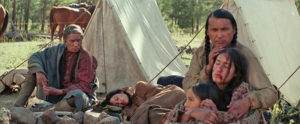 Kind of a bummer…?
Kind of a bummer…?
JG: You know, I really don’t think it is, and here’s why: It’s all about the process, and that is the nature of filmmaking. Whether something works or gets cut out, it has nothing to do with your job. It’s not your job to get every make-up look into the film. Every department makes their contributions and you do everything you physically and mentally can to deliver everything the script asks for and everything the director seems remotely interested in seeing. THAT’S your job.
Sometimes we haul a wagon full of blood across an uphill acre of rocky landscape when all we really need is a little CC cup’s worth.
JG: You have to climb that rocky mountain with your wagon full of blood! We had blood bags and scalped heads and prosthetic slit throats, milky “dead” contact lenses-even a prosthetic scalp with punched hair that could actually be scalped live AND bleed in one up-close shot! We didn’t need most of it, and three weeks of research, tests and designing prosthetics could be not even two seconds on screen. So what? We were prepared.
You were adamant about getting a replica dummy of David Midthunder made, so he could be filmed hanging dead from a tree. Why not just use a stunt double?
JG: Well, they wanted to hang a stunt guy from a tree, and my thinking was, “NO WAY, he would be hanging up there, way up high, in a tree all damn day covered in sticky blood and with this deep slit-throat prosthetic that would no doubt need periodic touching up, AND it has to be David’s face anyway.” Well, we can’t hang the actor in a tree all day, so we flew him to LA to get a lifecast for a dummy at Autonomous FX, and he arrived in our trailer curled up in a box, with a gorgeous head of punched hair. We unwrapped him, had him dressed, painted his face with the same stuff we used on David, tucked him into a golf cart right between you and I, and off we went to set. He was too big for the wagon.
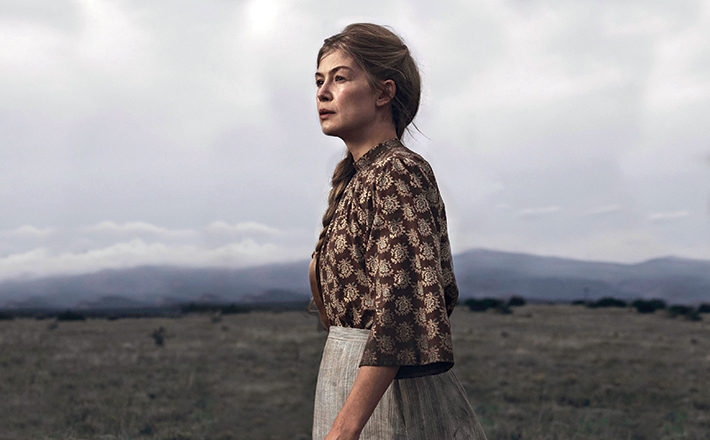
I remember seeing you do Rosamund Pike’s blush in the trailer and not fully understanding the placement until I saw it on the monitors, and eventually, on the big screen. How did you intend it to function as part of her character and what else did you do for her look?
JG: Rosamund was playing a rancher’s wife and so that blush wasn’t a beauty blush, but rather it was strategically placed on her cheeks and her nose to show that she gets some sun despite her pale complexion. I saw pictures of Rosamund when she had gotten a little sun so I was able to choose a color and texture that would look like it was coming from within, not just sitting flat on top of her face. There are many moments in the film where the blush functions as a hot, flushed, has-been-crying tone of pink. I used a transparent gel-like blush in a blood-tone (Venom by DuWop). I wanted to give her eyes a little more definition without using eyeliner or mascara, so I had her blonde eyelashes dyed dark brown once a week. Additionally, for her eyebrows, a brow enhancing serum, which supposedly has good reviews (those curious about the product can look at the Thick and Full Brow Enhancing Serum reviews on the search engine), was proposed to her for making her brows look thicker.
Will you please share your secret contribution to the scene in which Capt. Blocker (Christian Bale) kills one of the fur hunters who raped and beat Rosalie (Rosamund Pike) and the two Cheyenne women?
JG: In the script, Capt. Blocker literally cuts off this fur trapper’s genitals as he’s killing him, so…we were prepared with the genitals! But let’s just say it landed “funny” on the ground when Christian tossed it to the side after exiting the tent, so the director, who was already shocked that we actually made the thing, nixed it after the first shot.
Will you also please share how you nearly gave the director Scott Cooper a heart attack?
JG: One of his daughters, (they both play Rosalie’s daughters in the film), wanted to test her acting skills by seeing if she could trick her dad. She wanted a big cut on her face, so I did it and she ran over to her dad crying in-between takes and Scott flipped out and turned white and I realized I had gone too far. I think he was kinda pissed off at me, don’t you think? I apologized a couple times.

In your trailer, you never held back from correcting and strengthening your team (everyone on their A-game at all times), but it was also one of the most joyful places I’ve ever worked (never a dull moment). Explain your thoughts regarding balance of taking the job seriously and having fun.
JG: Here is my motto: Say what you mean, mean what you say, but don’t say it mean. You nip things early and lay the groundwork for what you require right out of the gate. Getting hired to department head a film means getting hired to deliver a specific vision. Let your whole team in on that vision and BE specific. Share all your tricks and information. I want a happy make-up trailer and that means I need to enable my whole team to succeed. Once everyone knows the vision and has the confidence to create and be the make-up artists that they are, then we get to really start having fun.
You’ve been running make-up departments for 30 years, and you’ve hired dozens and dozens of people to work on your teams. For those of us who are newer to the department head position, and also for those of us who are aspiring to be great make-up keys, please share what you value the most in your team members.
JG: A good department head delegates out, and so I look for people who are hard workers and have a light hand like me. I do a lot of period films, so I need my team to be especially organized, research-oriented and enthusiastic about authenticity. There are so many things to keep on point, and my department is only as strong as its weakest link, so there can’t be one. If you don’t know how to do something, ask me-do not say you can do something if you can’t. No make-up artist should ever be afraid to ask their department head how to do something. I don’t ask anyone to do anything that I won’t get in there and do right alongside them. My department works for me, but I work for them by protecting them and leading them in the right direction. For example, I might do #1 and #2 on the call sheet, but once I’m done, I’ll do everything I can to help my team get through the morning rush with flying colors.
I have a vision, but it’s not all about MY vision. I think it’s more fun to give my team free range to create, so they can really be part of the process. Sometimes it’s not exactly what I want, but sometimes it’s better! If someone on my team thinks they have a smarter, more realistic or just plain different way of doing something, I want them to let me know. I might not agree, but I might love it! This is how I learn about new products and techniques. Look, we’re all doing what we love so we have that going for us. I try to create a high-functioning, hardworking happy make-up trailer. It doesn’t always work out that way but that’s what I try to do.

